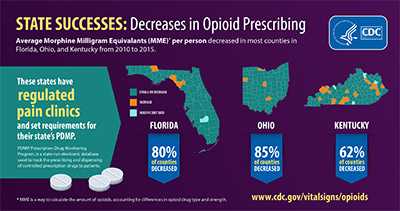State Successes
State-level policies that enhance prescription drug monitoring programs (PDMPs) or regulate pain clinics have shown some promising results. Below are a few examples of states that have made a difference:

Ohio and Kentucky
In 2011 and 2012 respectively, Ohio and Kentucky mandated clinicians to review prescription drug monitoring program (PDMP) data and implemented pain clinic regulation. In these states, MME per capita decreased in 85% and 62% of counties, respectively, from 2010 to 2015.
Florida1
In Florida, where multiple interventions targeted excessive opioid prescribing from 2010-2012, (e.g., pain clinic regulation and mandated PDMP reporting of dispensed prescriptions)1, amounts of opioids prescribed decreased in 80% of counties from 2010 to 2015. During this time period, Florida also experienced reductions in prescription opioid-related overdose deaths.
- 2010 Action: Regulated pain clinics and stopped health care providers from dispensing prescription opioid pain relievers from their offices, in combination with establishing a PDMP.
- 2012 Result: Saw more than 50% decrease in oxycodone overdose deaths.
- These changes might represent the first documented substantial decline in drug overdose mortality in any state during the previous ten years.

New York2
- 2012 Action: Required prescribers to check the state’s PDMP before prescribing opioids.
- 2013 Result: Saw a 75% drop in patients’ seeing multiple prescribers for the same drugs.
Tennessee2
- 2012 Action: Required prescribers to check the state’s PDMP before prescribing painkillers.
- 2013 Result: Saw a 36% decline in patients’ seeing multiple prescribers for the same drugs.
Oregon
Successes for a Core Violence and Injury Prevention Program Funded Grantee
As a Core Violence and Injury Prevention Program funded grantee, the Oregon Health Authority (OHA) reports the rate of poisoning due to prescription opioid overdose in Oregon declined 38% between 2006 and 2013 (from 6.6 to 4.5 per 100,000 residents). Oregon’s rate of death associated with methadone poisoning decreased 58% in the same time period. Key initiatives to address the problem include the:
- establishment of a PDMP to track prescriptions of controlled substances;
- implementation of prior authorization for Methadone doses > 100mg/day under Medicaid;
- education and access of lay persons to provide naloxone to persons suspected of overdose; and
- physician and allied health care trainings about safe and effective pain care.
OHA continues to promote adoption of their PDMP, and works with health systems, insurers and other partners to increase access to medication assisted treatment and non-pharmaceutical pain care for chronic non-cancer pain.
You can learn more about OHA’s efforts at http://www.orpdmp.com.
References
- Centers for Disease Control and Prevention. Decline in Drug Overdose Deaths After State Policy Changes — Florida, 2010–2012. MMWR 2014; 63(26);569-574.
- PDMP Center of Excellence at Brandeis University. Mandating PDMP participation by medical providers: current status and experience in selected states [PDF File], 2014. Available from: http://www.pdmpexcellence.org/sites/all/pdfs/COE%20briefing%20on%20mandates%20revised_a.pdf.
- Page last reviewed: August 24, 2017
- Page last updated: August 24, 2017
- Content source:
- Centers for Disease Control and Prevention,
- National Center for Injury Prevention and Control,
- Division of Unintentional Injury Prevention


 ShareCompartir
ShareCompartir
